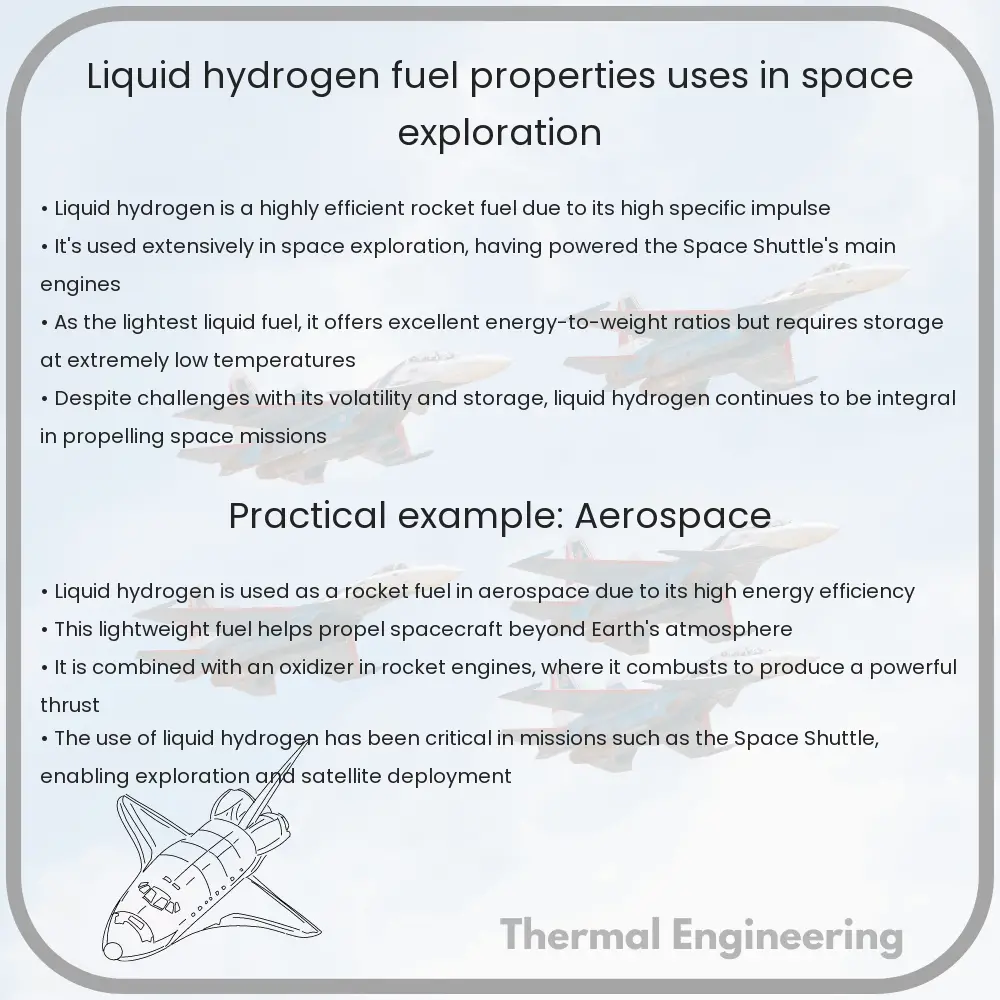Understanding liquid hydrogen’s role in space exploration, its properties, usage as fuel, and the challenges in storing and handling it.

Liquid Hydrogen: Fuel Properties and Its Uses in Space Exploration
Liquid hydrogen (LH2) is a form of hydrogen which is particularly useful in various high energy applications, including space exploration. This article delves into the key properties of liquid hydrogen and its significant role in propelling spacecraft.
Properties of Liquid Hydrogen
Liquid hydrogen is hydrogen in its liquid state, which it maintains at extremely low temperatures. It must be kept below its boiling point of -252.87°C (-423.17°F) under atmospheric pressure. Here are some crucial properties and benefits of liquid hydrogen:
- High Energy Content: Hydrogen has the highest energy content per mass of any fuel, at about 120-142 MJ/kg (megajoules per kilogram), which makes it extremely efficient compared to other types of fuel.
- Low Density: It has a low density of about 71 kg/m3, which presents challenges in terms of storage and transport because large volumes are required to store substantial amounts.
- Cryogenic: As a cryogenic liquid, liquid hydrogen requires specialized insulated containers and pipelines to handle and maintain its extremely cold state.
- Clean Combustion: When burned, hydrogen produces water vapor as exhaust, making it an environmentally clean option with no direct emissions of pollutants or greenhouse gases.
Uses in Space Exploration
Liquid hydrogen has been an instrumental fuel in the realm of space exploration, particularly as a rocket propellant. Below are its primary applications in this field:
- Main Propellant: It is commonly used as the main propellant in rocket engines, often combined with an oxidizer such as liquid oxygen (LOX). This combination is used in both the Space Shuttle main engines and the Centaur upper stage engine.
- High Specific Impulse: Liquid hydrogen offers a high specific impulse, which is an important measure of rocket engine efficiency. This attribute means rockets can achieve higher speeds and carry more payload relative to the amount of fuel carried.
- Use in Fuel Cells: Beyond its use in rocket engines, liquid hydrogen is also employed in fuel cells to generate electrical power for spacecraft. These fuel cells produce electricity, heat, and water (which can be used by astronauts for drinking).
Challenges and Future Prospects
Despite its usefulness, the utilization of liquid hydrogen in space exploration presents several challenges:
- Storage Issues: Its low density and cryogenic nature necessitate sophisticated and bulky storage systems to maintain it in liquid form, which can be a constraint in spacecraft design.
- Volatility: Hydrogen is highly flammable and requires robust safety measures to prevent and control any leakage or accidental ignition.
- Cost: The production, storage, and transport of liquid hydrogen are costly and energy-intensive processes, although ongoing research aims to make these more efficient and sustainable.
In conclusion, liquid hydrogen remains a cornerstone in the field of space exploration due to its high energy efficiency and clean combustion properties. Ongoing advancements in technology and material science continue to address the existing challenges associated with its use, promising even broader applications in the future of aerospace and beyond.